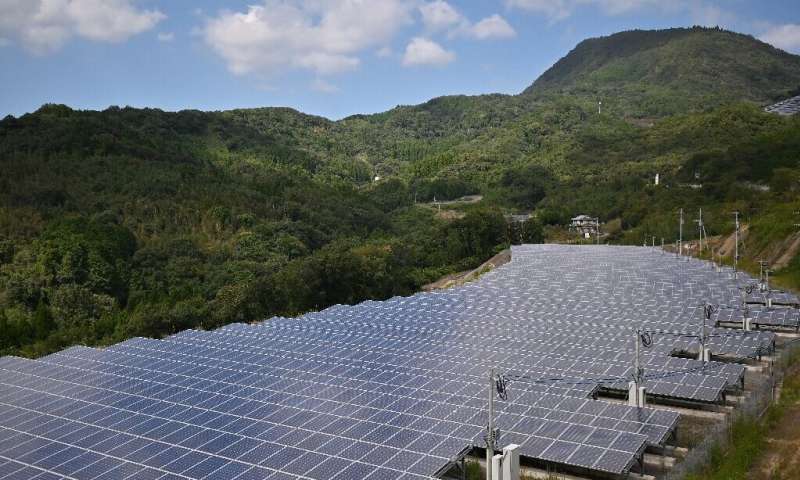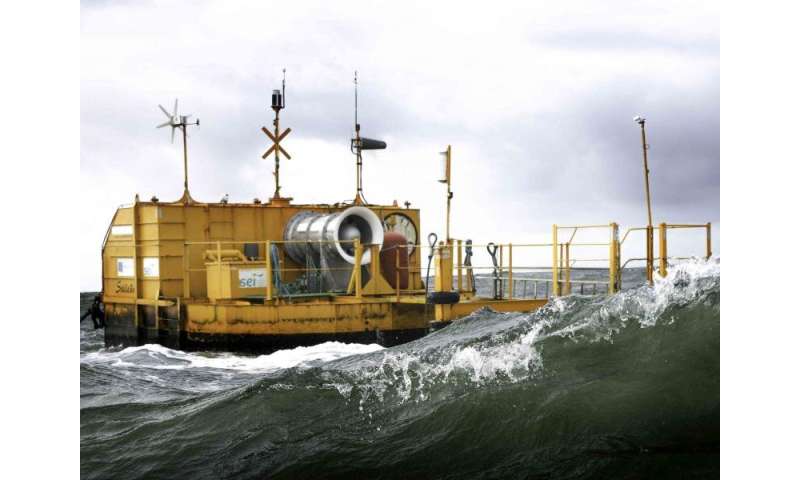
© Laura Sciarpelletti/CBC Ian Crosbie with a 10-week-old Wagyu-cross calf at Benbie Holsteins in south-central Saskatchewan, his farm just outside the village of Caronport, about 90 kilometres west of Regina.
Benbie Holsteins in south-central Saskatchewan milks 150 Holsteins every day, but the dairy farm does not need all of its heifer calves for milking, so the remainder are used for something very different: snow beef.
Snow beef comes from artificially inseminating a Holstein heifer with whole blood Japanese Wagyu, the world's most expensive and exclusive beef.
After becoming interested in the luxury beef's story, farmer Ian Crosbie bought full blood semen from Wagyu Sekai in Puslinch, Ont., and began an artificial insemination program. He launched the snow beef product in 2018 at his farm just outside the village of Caronport, about 90 kilometres west of Regina.
"It was an investment; a bit of a risk at the time, too," said Crosbie, who would not say how much it cost him. "But it all stemmed from us doing a better job of managing our dairy herd to begin with."
Canada's beef industry produces about 1.55 million tonnes of meat each year, according to the Canadian Cattlemen's Association. In 2019, the cattle industry generated $9.4 billion in farm cash receipts
Benbie Holsteins in south-central Saskatchewan milks 150 Holsteins every day, but the dairy farm does not need all of its heifer calves for milking, so the remainder are used for something very different: snow beef.
Snow beef comes from artificially inseminating a Holstein heifer with whole blood Japanese Wagyu, the world's most expensive and exclusive beef.
After becoming interested in the luxury beef's story, farmer Ian Crosbie bought full blood semen from Wagyu Sekai in Puslinch, Ont., and began an artificial insemination program. He launched the snow beef product in 2018 at his farm just outside the village of Caronport, about 90 kilometres west of Regina.
"It was an investment; a bit of a risk at the time, too," said Crosbie, who would not say how much it cost him. "But it all stemmed from us doing a better job of managing our dairy herd to begin with."
Canada's beef industry produces about 1.55 million tonnes of meat each year, according to the Canadian Cattlemen's Association. In 2019, the cattle industry generated $9.4 billion in farm cash receipts
.

© CBC Crosbie, who grew up on a farm, launched his snow beef product in 2018. 'It was an investment; a bit of a risk at the time, too,' he says.
There are only a handful of snow beef producers in Canada, but Crosbie's leap of faith is a sign of how some are getting creative with their products as a way to stand out in a massive market and appeal to consumers who are increasingly conscious of the quality of the meat they're buying and its origin story.
Interest in cattle breeding runs deep
Crosbie, 29, has been fascinated with animal breeding since he was 10 years old. Growing up on a farm, he loved picking out which Holstein bulls his family was going to use next for breeding.
"I've been very fascinated with seeing what you can produce from just a thought in your own head, to applying it practically on the farm — what you can wind up producing and how you can see the change in the animals over the generations," he said.
Crosbie's great-grandfather established the farm west of Moose Jaw, Sask., after the Second World War, and it has been family owned and operated ever since.
"It's been in my blood. It was right from the get-go. I always remember racing Dad in the winter months back from the barn.... That's stuck with me forever. It never crossed my mind to do anything other than farming."
There are only a handful of snow beef producers in Canada, but Crosbie's leap of faith is a sign of how some are getting creative with their products as a way to stand out in a massive market and appeal to consumers who are increasingly conscious of the quality of the meat they're buying and its origin story.
Interest in cattle breeding runs deep
Crosbie, 29, has been fascinated with animal breeding since he was 10 years old. Growing up on a farm, he loved picking out which Holstein bulls his family was going to use next for breeding.
"I've been very fascinated with seeing what you can produce from just a thought in your own head, to applying it practically on the farm — what you can wind up producing and how you can see the change in the animals over the generations," he said.
Crosbie's great-grandfather established the farm west of Moose Jaw, Sask., after the Second World War, and it has been family owned and operated ever since.
"It's been in my blood. It was right from the get-go. I always remember racing Dad in the winter months back from the barn.... That's stuck with me forever. It never crossed my mind to do anything other than farming."
Raising Wagyu-cross breeds
The snow beef difference isn't just buried in its DNA. Regular Holsteins are black and white, but the Holstein heifers that have been artificially inseminated with Wagyu semen produce calves that are only black at birth.
Crosbie said Wagyu crosses also have distinctly healthy characteristics.
"They come out with a lot of hybrid vigour, because when you cross two very distinct bloodlines, you get extremely aggressive, healthy calves right from the get-go. They just do really well."
Another trait that sets the Wagyu crosses apart from Holstein dairy cows is their temperament. The crosses are extremely friendly and will nuzzle humans.
Wagyu crosses are also more lean and feminine-looking than a typical Holstein, and they take longer to reach their peak size.

© Laura Sciarpelletti/CBC One of the massive Wagyu-cross cows in the finishing pen at Benbie Holsteins.
By the time Holsteins are a year old, they're put on a full regimented finishing diet and will be on feed for about 150 days to add weight. When they hit the optimal 590-kilogram mark, they're between 15 and 18 months old. That's when they are sent to the abattoir.
But Wagyu crosses only start their finishing diet when they are about 15 months old, and they won't head to the abattoir until they are 28 or 29 months old. This allows them to grow much taller than a typical Holstein and put on massive frames.
The crosses are fed a specialized grain regimen of rolled barley, whole oats, distiller's grain from wheat or corn, molasses and a mineral mixture imported from Texas.
"That helps us get the fat content," Crosbie said. "The oleic acid levels actually rise the longer an animal's on feed, too. You're putting more money into it, but what you get out of is very much so worth it."
By the time Holsteins are a year old, they're put on a full regimented finishing diet and will be on feed for about 150 days to add weight. When they hit the optimal 590-kilogram mark, they're between 15 and 18 months old. That's when they are sent to the abattoir.
But Wagyu crosses only start their finishing diet when they are about 15 months old, and they won't head to the abattoir until they are 28 or 29 months old. This allows them to grow much taller than a typical Holstein and put on massive frames.
The crosses are fed a specialized grain regimen of rolled barley, whole oats, distiller's grain from wheat or corn, molasses and a mineral mixture imported from Texas.
"That helps us get the fat content," Crosbie said. "The oleic acid levels actually rise the longer an animal's on feed, too. You're putting more money into it, but what you get out of is very much so worth it."
Tasting the difference
The main thing that sets a Wagyu steak apart from a regular steak is the fat. Wagyu contains intramuscular fat or marbling — contributing to the name "snow beef." This is hailed by chefs and home cooks alike because of the rich, buttery texture it provides.
"The fat itself is just a completely different fat," Crosbie said.
Snow beef is higher in unsaturated fats and lower in saturated fats.
"It's like the difference in going and getting a vegetable oil in the supermarket: You can get your cheapest oils, your canola oils, your sunflower oils or your olive oils. There's a wide variety of them, and with beef it's no different," he said.
"When you cook that steak, all that fat will melt away, and that's what gives you that buttery taste to the meat and gives you a really good texture — and the best bite of steak you'll have in your life."
Chef takes note
Jonathan Thauberger, executive chef and partner at Crave Kitchen and Wine Bar in Regina, had never had Wagyu crossed with Holstein beef before he tried Crosbie's snow beef.
"When we came across the Holsteins [cross], it was really interesting. The strip loin is about twice the size of an Angus-Wagyu cross. It's very big, very long and pretty incredible," Thauberger said.
"To my palate, I find it almost tastes a little bit more beefy. It's rich. It's got a little bit more flavour. It's very delicious."

© Laura Sciarpelletti/CBC Jonathan Thauberger, executive chef and partner at Crave Kitchen and Wine Bar in Regina, preparing snow beef carpaccio.
Thauberger uses every part of snow beef that comes through his restaurant's kitchen doors when he orders it. Snow beef is sometimes offered as a butcher's cut and a carpaccio on the menu, among other items. He even makes pemmican — whipped snow beef fat with snow beef jerky and dried fruit.
He said his customers particularly appreciate hearing the story of where the snow beef comes from.
"You're talking about a local farmer who's doing this boutique product. You can come here on any particular day and have a different cut from this animal and taste how it's different from cut to cut, animal to animal, even. It's a great story."
Thauberger uses every part of snow beef that comes through his restaurant's kitchen doors when he orders it. Snow beef is sometimes offered as a butcher's cut and a carpaccio on the menu, among other items. He even makes pemmican — whipped snow beef fat with snow beef jerky and dried fruit.
He said his customers particularly appreciate hearing the story of where the snow beef comes from.
"You're talking about a local farmer who's doing this boutique product. You can come here on any particular day and have a different cut from this animal and taste how it's different from cut to cut, animal to animal, even. It's a great story."

© Laura Sciarpelletti/CBC The rich marbling of snow beef can be seen in Crave's carpaccio.
Consumers looking to feel connected to farms
Jeff Nonay and his wife run a mixed dairy farm in Sturgeon County, Alta. They produce dairy, cheese, potatoes and beef — Wagyu-cross beef, to be exact. Like Crosbie, Nonay crosses the Wagyu genetics with Holstein genetics.
Nonay, who's been marketing his product for four years, said that while he cannot produce on a large scale, the demand and interest are there.
"When you think about Alberta and you think about beef, being able to brand something off a specific farm and consistently produce quality that becomes recognized is a pretty interesting feat," he said.
"It tells you quite a bit about what consumers want and the connection they have directly to the farm, adding value, adding to the experience."

© Amara Dirks Photography Jeff Nonay and family with their Wagyu-crosses and Holstein cows at their mixed dairy farm in Sturgeon County, Alta.
Nonay said the Wagyu-cross market is a niche one, so there is potential for it to grow exponentially.
Ryder Lee, CEO of the Saskatchewan Cattlemen's Association, said products such as snow beef help to connect consumers with what producers are doing in genetics.
"I think that's something that all cattle producers would like to do but aren't always able to do," Lee said.
His father experimented with genetics in the 1970s, bringing semen from the United States to crossbreed his herd with.
"They were actually called exotic breeds, and they are now part of the mainstream in Canada."
Lee said things have since changed due to producers' ability to communicate their breeding stories with the media and consumers.
"I think the mainstream industry is now just trying to make sure that people know the story of Canada — know the story about cattle on the land and the good that we provide for the habitat, for the environment and for your diet."
Nonay said the Wagyu-cross market is a niche one, so there is potential for it to grow exponentially.
Ryder Lee, CEO of the Saskatchewan Cattlemen's Association, said products such as snow beef help to connect consumers with what producers are doing in genetics.
"I think that's something that all cattle producers would like to do but aren't always able to do," Lee said.
His father experimented with genetics in the 1970s, bringing semen from the United States to crossbreed his herd with.
"They were actually called exotic breeds, and they are now part of the mainstream in Canada."
Lee said things have since changed due to producers' ability to communicate their breeding stories with the media and consumers.
"I think the mainstream industry is now just trying to make sure that people know the story of Canada — know the story about cattle on the land and the good that we provide for the habitat, for the environment and for your diet."

© Laura Sciarpelletti/CBC A snow beef steak, left, and a regular steak, right.
Snow beef sales increasing
Prairie Meats in Saskatoon is the latest business to partner with Crosbie and sell packaged snow beef cuts. CEO Casey Collins said that Saskatchewan residents are keen to support local farmers when they're at the butcher shop.
"This allows them to have a high-end dining experience but also understand where it came from and stay within 50 miles of where they live."
Prairie Meats in Saskatoon is the latest business to partner with Crosbie and sell packaged snow beef cuts. CEO Casey Collins said that Saskatchewan residents are keen to support local farmers when they're at the butcher shop.
"This allows them to have a high-end dining experience but also understand where it came from and stay within 50 miles of where they live."

© Radio-Canada Prairie Meats in Saskatoon carries Ian Crosbie's Saskatchewan Snow Beef.
Benbie Holsteins markets snow beef exclusively in Saskatchewan. Ian Crosbie, the owner, said it is difficult for small farms and niche brands to market their product nationally due to federal plant restrictions.
"That makes it difficult for small niche beef brands to grow."
But he is hopeful.
Benbie Holsteins produced 6,800 kilograms of beef this year, and Crosbie said he hopes to double that by 2022.
Collins said the market has changed over the years: People's diets are different due to the amount of protein they are being told to consume, and their palates are changing.
"In 2019, consumption of beef per capita amounted to around 27.4 kilograms in Canada," according to Statista, a market and consumer research company based in Germany. "This figure is forecast to decrease to 26.7 kilograms in 2021. This expected decrease follows a long-term downward trend: in the year 1980, consumption per capita was 38.8 kilograms."
"The trend is that they're not eating red meat maybe as often as they used to, but when they do, they want to make sure it's a great experience," Collins said.
"And the fact is that even producers in general are having to pay more focus to how they raise their animals, how they grade out, how the quality is. And Ian is doing an excellent job of that."
"That makes it difficult for small niche beef brands to grow."
But he is hopeful.
Benbie Holsteins produced 6,800 kilograms of beef this year, and Crosbie said he hopes to double that by 2022.
Collins said the market has changed over the years: People's diets are different due to the amount of protein they are being told to consume, and their palates are changing.
"In 2019, consumption of beef per capita amounted to around 27.4 kilograms in Canada," according to Statista, a market and consumer research company based in Germany. "This figure is forecast to decrease to 26.7 kilograms in 2021. This expected decrease follows a long-term downward trend: in the year 1980, consumption per capita was 38.8 kilograms."
"The trend is that they're not eating red meat maybe as often as they used to, but when they do, they want to make sure it's a great experience," Collins said.
"And the fact is that even producers in general are having to pay more focus to how they raise their animals, how they grade out, how the quality is. And Ian is doing an excellent job of that."












